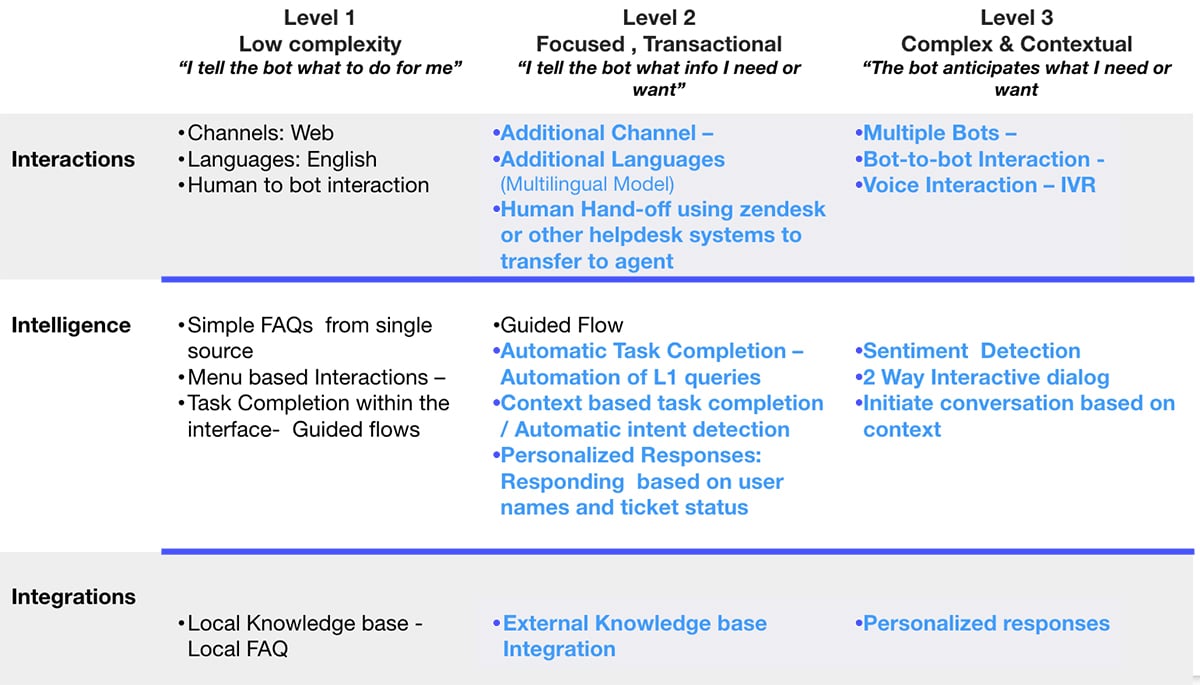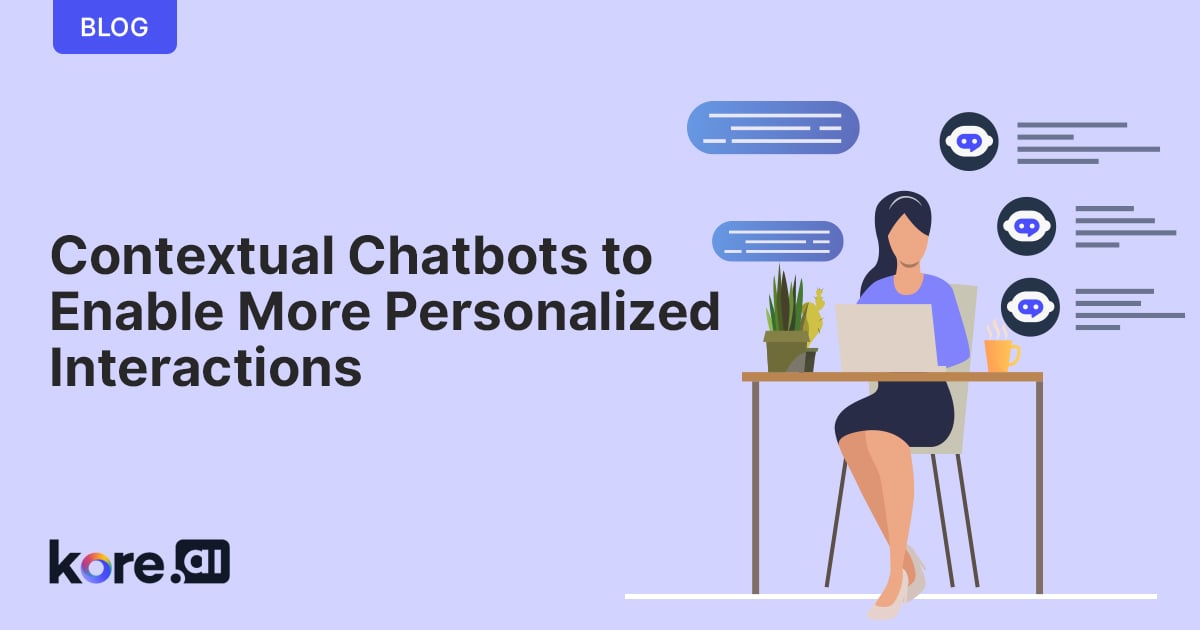Global research and advisory firm Gartner believe that approximately 85% of customer interactions will be handled by AI driven conversational chatbots in the next five years, stressing the need for more advanced automated conversational interactions more than ever. Most users are averse to getting their answers resolved by chatbots, this is due to the conversational depth and personalization customers are often looking for.
Let’s go over what contextual intelligence can do for your business and digital strategy, what drives it, and what technologies will be involved over the next few years.
Exploring Maturity Levels for Chatbot Capabilities
Looking at the evolution of chatbots and what maturity level you might be when deploying these solutions, it is important to track the trajectory of how advanced and personalized an experience you want to provide your customers in order to help your customers self-serve and automate most of the interactions seamlessly. There have been several levels and paths associated with the levels of maturity to what your chatbot can truly do for you. Over the past 8 years, virtual assistants have evolved through many levels.
The basic level 1 chatbots are essentially notification assistants where you simply receive notifications on specific use cases like ‘contract reminders and renewals for your phone or insurance’ and more. Then came the FAQ assistants that enabled users to receive immediate resources and helpful links to their problems; in this case, users could find more about their phone contract policies on their own. These are the most commonly used virtual assistants we see today, where chatbots can extract knowledge internally or externally to present to the user.
Level 3, however, takes it to another level where the bot anticipates what a user needs. This includes superior intelligence through sentiment detection and being able to have a 2-way interactive dialogue. For example, with contextual AI, you can make the virtual assistant recall historical data, user inputs, and previous interactions and even identify the caller’s emotional state to steer the conversation. This added intelligence would make the entire interaction considerably smarter, smoother, and more user-friendly.

NLP Enables the Intelligence a Chatbot Needs
Natural Language Understanding (NLU) is a subset of NLP that turns natural language into structured data. NLU is able to do two things — intent classification and entity extraction to be able to provide sentiment detection and the contextual intelligence you would expect from an advanced chatbot. Kore.ai’s proprietary natural language processing (NLP) technology detects users’ intent in the given context & extracts entities with very high accuracy by processing user inputs against three different engines.
The platform takes a unique hybrid approach to understanding user intent. It uses a machine learning model, a semantic rules-driven model, and a domain taxonomy and ontology-based model. This approach allows the virtual assistants to not only understand a user’s input with a high degree of accuracy, but also to handle complex human conversations intelligently.
The individual engines have many specialized capabilities but also have their own limitations. Kore.ai’s proprietary NLP technology overcomes the weakness of any one individual NLP model. The three engines complement each other with different perspectives. Their results are correlated and resolved to identify intents accurately. This method is unique to Kore.ai, while most other solutions depend solely on one.
Why Contextual Awareness is Critical to Your Intelligent Virtual Assistant
Context is so deeply embedded in human learning that it is easy to overlook its critical role in responding to a given situation. To illustrate this point, consider a conversation between two people that begins with a simple question: How is Grandma?
In a real-world conversation, this simple query could elicit any number of potential responses depending on contextual factors, including time, circumstance, relationship, etc.
The context of the utterance helps us find the entity. Should a customer say: “I want to travel to the Port of Hvar”
Even if we might not recognize this particular town or city, we realize it is an entity of a city.
So we use the context of the specific word in the sentence to know what it represents.
Secondly, we decompose the entity. Not only do we know it is a city, but it is a subtype of the destination city, as opposed to the city of departure.
Entity decomposition is vital for both intent prediction and for data extraction with the entity.
| We start by defining a single entity called |
|---|
| Travel Detail |
| Within this entity, we defined three sub-entities. The three subtypes defined are: |
|---|
| Time Frame |
| Mode |
| City |
| From here, we have a sub-sub-type for City: |
|---|
| From City |
| To City |
Customization: As you know, contextual AI has the ability to adapt to situations it hasn’t been specifically trained to handle. But just as you wouldn’t instantly excel at a brand new task, AI won’t always get everything right either.
For a contextual AI system to continually improve, one must be able to tweak its behavior so it can better meet expectations.
For example, if you develop a closed-domain chatbot with the sole purpose of tracking shopping orders, the bot will be able to work perfectly fine using a rule-based system. In contrast, a virtual assistant at an automated customer support call center will indeed cause human rage if it can’t make sense of basic requests.
Chatbots are business conversational specialists and hence must come with a great degree of contextual awareness. With the many chatbot platforms available in the market, selecting the right platform to provide a personalized and holistic experience for users is key.
During the chatbot design phase, the bot persona also needs to be aligned with the personality and values of the organization, resulting in improved user personification and contextualization. You can refer to Deloitte’s report on contextual chatbots, and their value in providing a more personalized experience.
Managing context management for your virtual assistants has never been easier, with Kore.ai’s platform continually improving its intelligence features, making the overall experience of using a bot simpler and better. Kore.ai provides the ability to manage context in multiple ways:
- Output Context to define tags that indicate the current intent is executed.
- Intent Preconditions to extract the output context tags for scoping the subsequent intent detection.
- Contextual Intent Detection using context tags to identify the terms/nodes from the FAQs.
- Conversation Flows to customize the flows.
Check out our blog on Why Contextual Awareness is Critical to Your Intelligent Virtual Assistant.
Sign up to our platform now to start building your bots with contextual intelligence.







